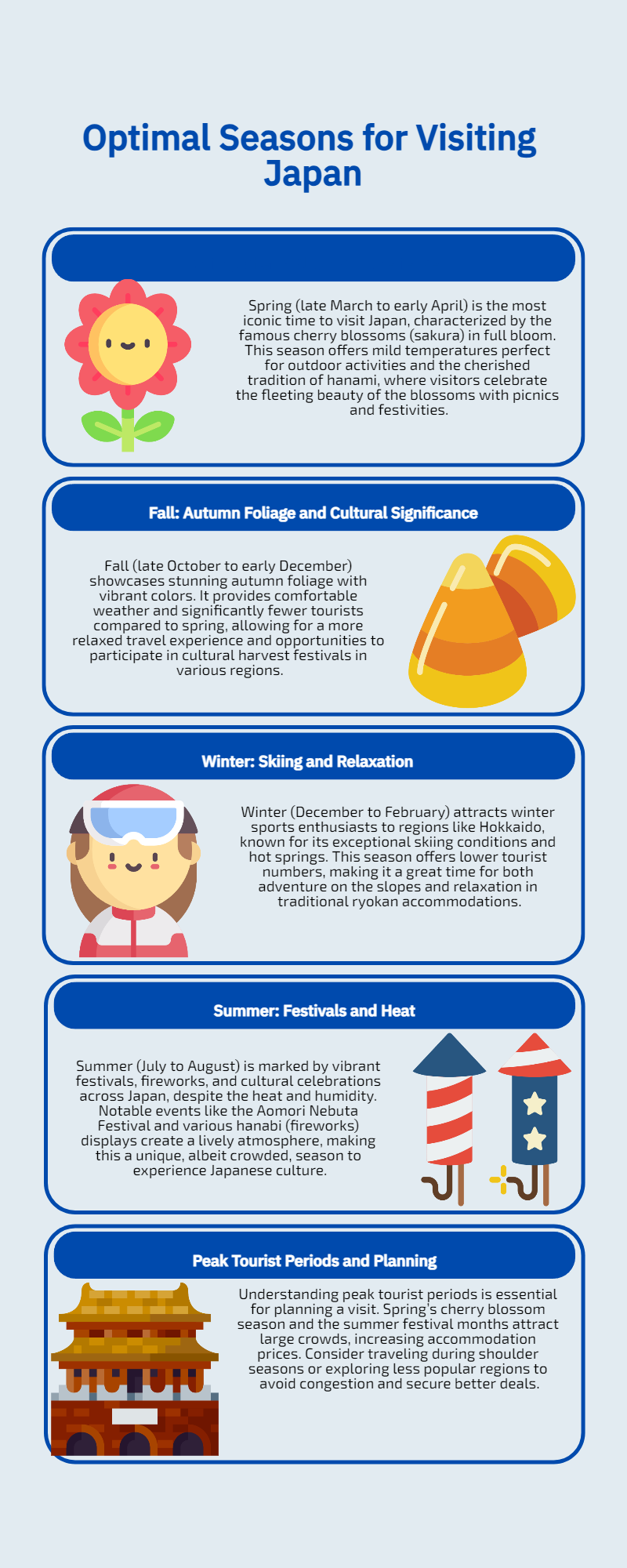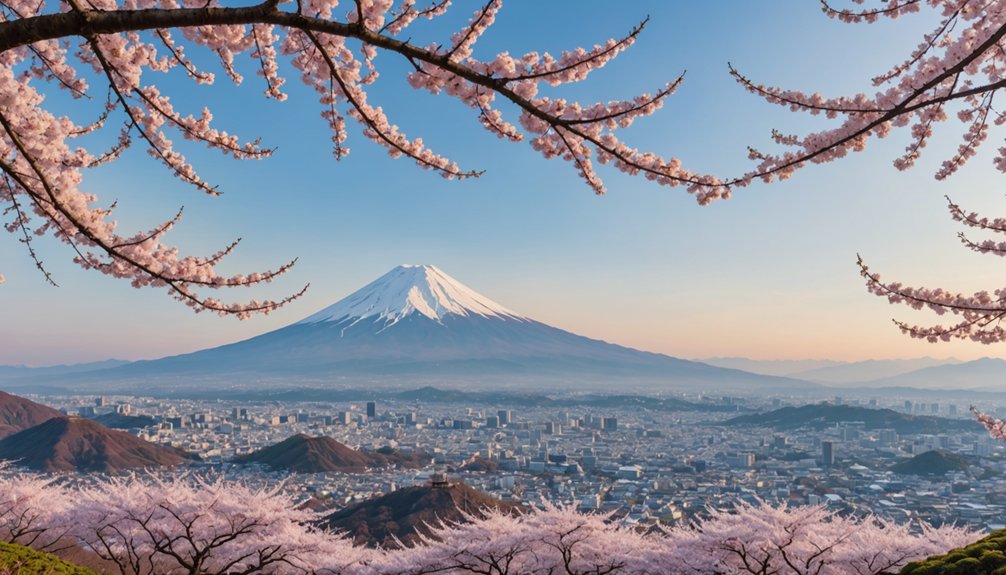The best time to visit Japan is during spring (late March to early April) when you’ll experience the iconic cherry blossoms, or during fall (late October to early December) for stunning autumn foliage and comfortable temperatures. Summer offers vibrant festivals and fireworks but can be humid, while winter brings pristine skiing conditions and hot springs. Each season delivers unique cultural experiences, from hanami parties to traditional matsuri celebrations, with peak viewing times varying by region and specific attractions.
Explore East Asia
Find the perfect time to visit these travel hotspots
Key Takeaways
- Spring (March-April) offers the most iconic experience with cherry blossoms in full bloom and comfortable temperatures for outdoor activities.
- Fall (October-November) provides stunning autumn foliage, mild weather, and fewer tourists than peak spring season.
- Winter (December-February) is ideal for snow sports enthusiasts and hot spring experiences, especially in Hokkaido.
- Summer (July-August) features vibrant festivals and fireworks but can be uncomfortably hot and humid with heavy crowds.
- Late fall (November) or early spring (March) offers pleasant weather and lower tourist numbers for budget-conscious travelers.
Understanding Japan’s Four Distinct Seasons
Why does Japan captivate visitors year-round? The country’s four distinct seasons offer dramatically different experiences, each with its own cultural significance and natural beauty.
Spring welcomes you with mild temperatures between 13°C-23°C and the famous cherry blossoms, while summer brings festivals and fireworks despite temperatures soaring past 30°C. You’ll need to plan around the rainy season‘s impact during June-July, when humidity peaks and rainfall is persistent. These seasonal shifts require visitors to change their clothes accordingly.
Autumn rewards travelers with comfortable weather (15°C-20°C) and stunning foliage displays, particularly in Kyoto and Nikko. Winter transforms the landscape, especially in Hokkaido, where temperatures drop below freezing and snow blankets the region.
Each season presents unique seasonal cuisine highlights – from spring’s sakura mochi and fresh bonito to winter’s warming hot pots and citrus fruits. You’ll discover that Japan’s seasonal changes influence everything from food to festivals, creating distinctly different travel experiences throughout the year.
Cherry Blossom Season: A Spring Spectacle
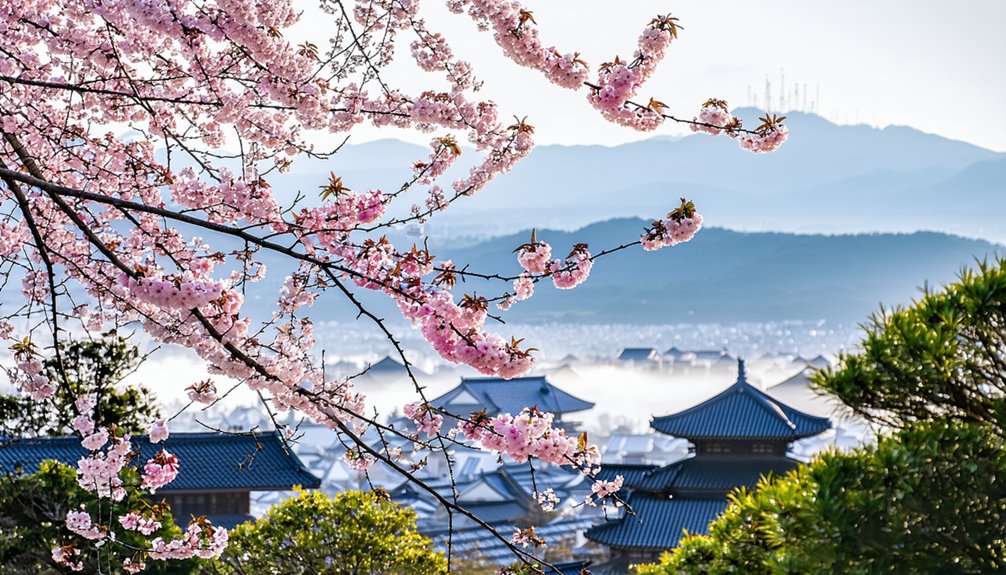
Japan’s iconic cherry blossom season follows a predictable northward progression, starting in late March in southern Kyushu and reaching Hokkaido by early May. You’ll find peak viewing in major cities like Tokyo around April 1st and Kyoto near April 6th, with blooms typically lasting about two weeks from first opening to final petal fall. If you’re planning to experience multiple bloom periods, you can strategically “chase” the blossoms by starting in southern regions and gradually making your way north, though this requires careful advance planning due to high tourist demand. The Japanese tradition of hanami viewing parties brings locals and tourists together to celebrate the fleeting beauty of the blossoms with picnics and festivities under the pink canopy.
Peak Viewing Times
Three distinctive waves of cherry blossoms sweep across Japan from south to north, creating a spectacular spring phenomenon you’ll want to time perfectly. For prime cherry blossom tracking, target the first week of full bloom in your chosen destination: late March to early April in Tokyo, Kyoto, Osaka, and Fukuoka, or late April to early May in Sapporo.
You’ll find the best seasonal photo opportunities during the initial 7 days of full bloom, before wind and rain accelerate petal fall. Plan your visit during weekdays to avoid peak crowds, and consider exploring both urban and rural viewing spots. While coastal and city areas bloom earlier due to warmer temperatures, mountainous regions offer extended viewing opportunities. Monitor weather forecasts closely, as unexpected cold snaps can delay flowering times. The blooming season begins with deep pink Ryukyu blossoms in Okinawa as early as January, offering an early preview of spring’s arrival.
Regional Bloom Patterns
While the cherry blossom season sweeps across Japan in a predictable wave, each region experiences its own unique blooming schedule. Beginning in Okinawa during mid-January, the blossoms march northward over 12 weeks, reaching Tokyo by late March and finally Hokkaido in early May. Climate change impacts have caused shifts in traditional patterns, with many regions now experiencing earlier blooms than in previous decades. You’ll find fascinating regional variations, from the early flourishing in Nagasaki and Hiroshima to the later displays in Sendai and Sapporo. Keep in mind that occasional off-season blooms can surprise visitors, particularly in November, offering unexpected viewing opportunities. Understanding these regional differences helps you plan your cherry blossom adventure with precision, whether you’re heading south for winter blooms or north for spring displays. Thanks to social media imagery collected over a decade, researchers have been able to track and verify these blooming patterns with remarkable accuracy.
Summer Festivals and Cultural Celebrations
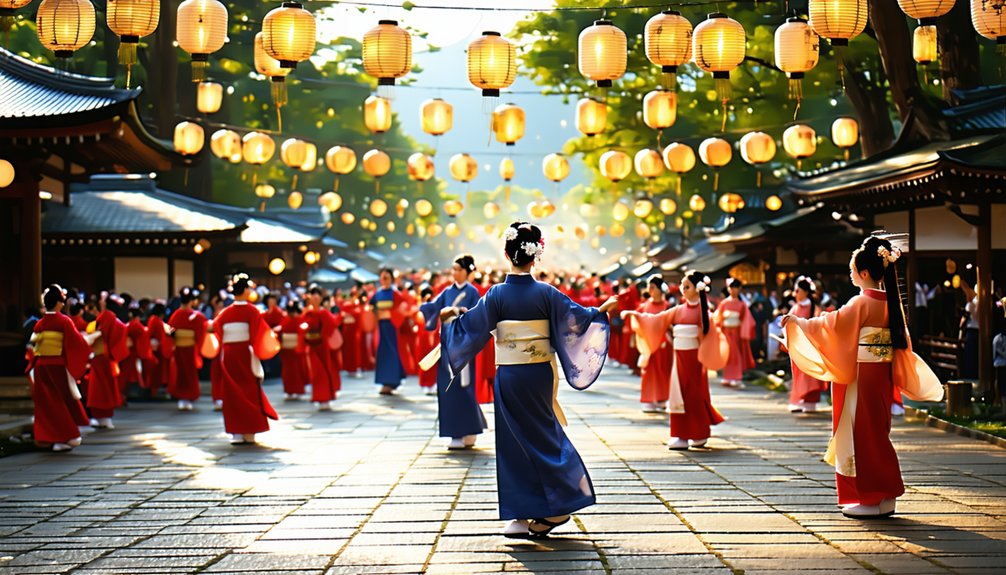
Japan’s vibrant summer festivals showcase the nation’s most spectacular cultural celebrations, from the towering illuminated floats of Aomori’s Nebuta Matsuri to the synchronized dancers of Tokushima’s Awa Odori. Visitors can immerse themselves in the festivities by renting Haneto costumes and joining the traditional dances. You’ll find evening skies illuminated by world-class firework displays, including Tokyo’s historic Sumida River Festival with its 20,000 pyrotechnic bursts. Traditional celebrations reach their peak in mid-August during Obon, when communities across Japan honor ancestors with lantern ceremonies, folk dances, and time-honored customs.
Major Matsuri Events
During the sweltering summer months, you’ll discover some of Japan’s most spectacular matsuri (festivals) in full swing, with the Tohoku region’s celebrations standing out as must-see events. The Aomori Nebuta Festival, running from August 2-7, transforms the city streets with massive illuminated warrior floats while portable street food vendors line the parade routes. Traditional dance performances and the rhythmic beats of taiko drums blend with haunting flute melodies to create an unforgettable atmosphere. Enthusiastic haneto dancers welcome visitors to join in the festivities alongside the floats.
Key festival highlights include:
- Giant float processions featuring intricately detailed samurai warriors
- Live performances combining traditional Japanese instruments
- Local food stalls offering regional summer delicacies
The nightly parades give you complete freedom to follow the festivities, whether you choose to dance alongside the floats or observe from the sidelines while sampling street cuisine.
Evening Firework Displays
Summer evenings in Japan burst into spectacular displays of hanabi (fireworks), a tradition dating back to the Edo period when they honored ancestral spirits during Obon. You’ll find some of the most impressive firework artistry at the Three Great Fireworks festivals: Nagaoka, Omagari, and Tsuchiura, where master craftsmen showcase their skills with up to 20,000 fireworks per event.
The festival atmosphere is electric, with locals dressed in yukata strolling among food stalls selling takoyaki and yakisoba. Spectators enthusiastically shout out Tamaya and Kagiya names during the displays, continuing a centuries-old tradition of praising these legendary firework makers. For the best experience, head to iconic events like the Sumidagawa Festival in Tokyo, which draws over a million spectators, or the Nagaoka Festival, featuring the legendary Phoenix display spanning 2km. Arrive early (around 3-4 PM) to secure prime viewing spots at major festivals.
Traditional Summer Celebrations
Throughout July and August, you’ll discover Japan’s most cherished cultural festivals transforming cities into vibrant celebrations of tradition and community spirit. The cultural significance of summer festivals peaks with spectacular events like Kyoto’s month-long Gion Matsuri, featuring ornate yamaboko floats, and Osaka’s Tenjin Matsuri with its dramatic water processions. The magnificent Sumida River Fireworks Festival amazes spectators with 20,000 fireworks displays along the riverbank.
- Aomori’s Nebuta Matsuri dazzles with massive illuminated warrior floats
- Tokushima’s Awa Odori fills streets with thousands of synchronized dancers
- Kyoto’s Gozan Okuribi lights up mountainsides with ceremonial bonfires
These elaborate festival decorations and floats showcase Japan’s artistic mastery and deep cultural roots. From Tanabata’s delicate bamboo decorations to Obon’s lantern ceremonies, each celebration offers unique insights into Japanese heritage while creating unforgettable summer memories.
Autumn Colors and Harvest Adventures
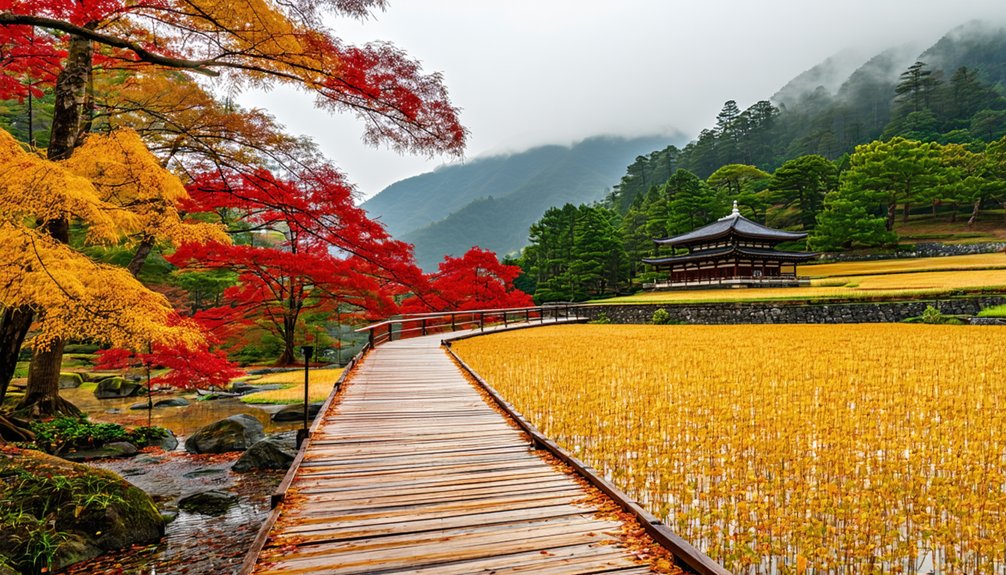
Japan’s autumn season transforms the country into a spectacular canvas of red, gold, and crimson foliage, with peak viewing times sweeping from north to south between September and December. You’ll find endless mountain trekking adventures, from the Tateyama Kurobe Alpine Route to Lake Towada’s reflective waters, while tasting regional cuisines at harvest festivals nationwide. Visitors in 2024 should expect heavier than normal crowds due to increased domestic and international tourism.
| Region | Peak Time | Must-Visit Spot | Festival Highlight |
|---|---|---|---|
| Hokkaido | Mid-Sept | Lake Towada | Sapporo Autumn Fest |
| Tochigi | Early Nov | Nikko UNESCO sites | Kurama Fire Festival |
| Kanazawa | Mid-Nov | Kenrokuen Garden | Takayama Festival |
| Kyoto | Late Nov | Kinkaku-ji Temple | Jidai Matsuri |
For the ultimate autumn experience, combine temple visits with seasonal moon-viewing parties and onsen soaks. Plan your travels during weekdays to avoid crowds, and secure accommodations early, especially in popular destinations like Kyoto and Osaka during their peak foliage periods.
Winter Wonderland: Snow Sports and Hot Springs
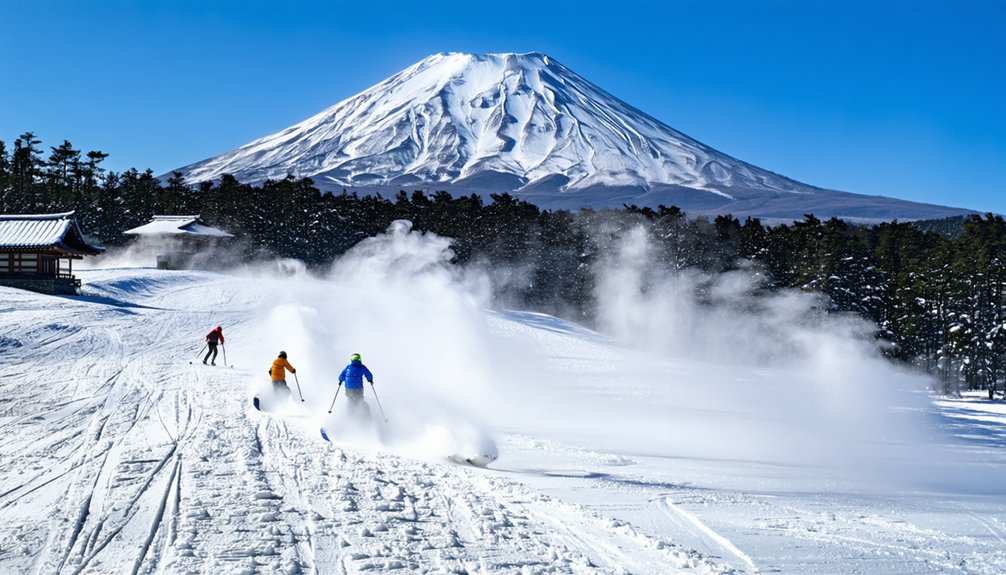
When pristine powder snow blankets the mountains from December through March, you’ll discover why Japan ranks among the world’s premier winter destinations. The legendary powdery snow quality, particularly in Hokkaido where Siberian winds create perfect conditions, draws winter sports enthusiasts from around the globe. Niseko and Rusutsu offer world-class skiing, while traditional ryokan experiences near the slopes let you soak in mineral-rich hot springs after an exhilarating day outdoors. Top resorts like Lotte Arai and Seki Onsen receive an impressive 16 meters of snow per season.
Perfect powder and world-class slopes make Japan’s winter resorts an unmatched destination for ski enthusiasts seeking adventure and relaxation.
- Gassan ski resort boasts Japan’s highest snowfall at 30 meters annually
- Hakuba’s Olympic-grade terrain caters to all skill levels
- Combine skiing with therapeutic dips in Noboribetsu’s famous sulfur springs
Winter’s lower tourist numbers mean you’ll find better hotel rates in major cities, making it an ideal time to mix urban exploration with mountain adventures. Whether you’re carving through Hokkaido’s pristine powder or relaxing in a steaming onsen surrounded by snow-covered peaks, winter in Japan offers an unmatched combination of sport and serenity.
Peak Tourist Periods to Consider
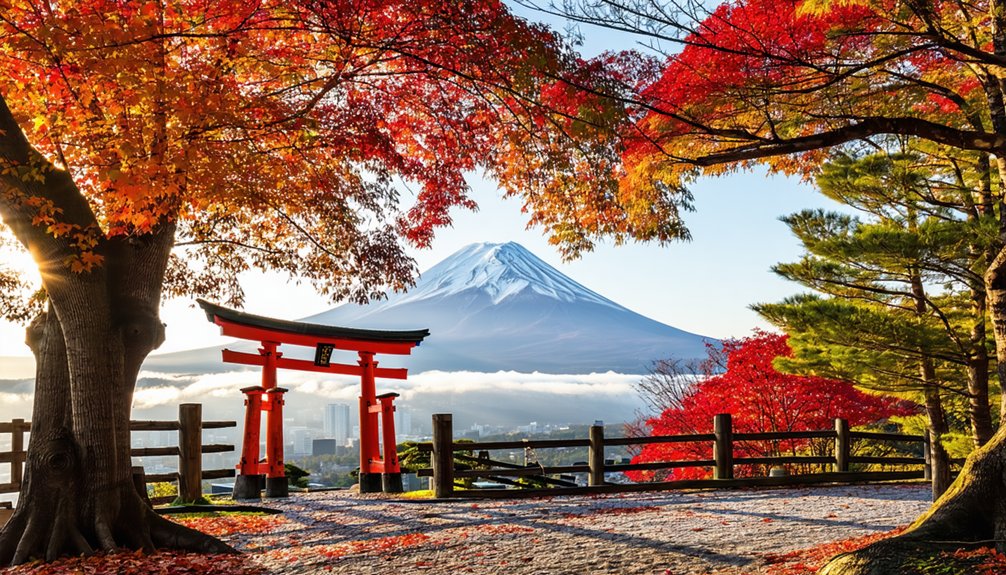
Understanding Japan’s peak tourist periods is essential for planning your visit, as specific seasons draw massive crowds that can impact both your experience and budget. Cherry blossom season (March-April) attracts over 63 million travelers, while Golden Week (late April-early May) sees both domestic and international tourism spikes, with accommodation prices soaring up to 50% above normal rates.
Careful accommodations planning becomes indispensable during summer festivals, particularly July’s Gion Matsuri, which draws over a million attendees. The autumn foliage season (October-November) brings 2.5+ million monthly visitors to popular destinations like Kyoto and Nikko. For festival crowd management, consider visiting during shoulder seasons or exploring less-frequented areas. Based on recent data, visitors typically spend 7.3 days exploring Japan, allowing time to experience multiple seasonal highlights. Year-end holidays (December-January) present another surge, especially at ski resorts and shrines. If you’re seeking more flexibility and lower prices, target the periods between these peak seasons, when you’ll find better deals and fewer crowds.
Weather and Climate by Region
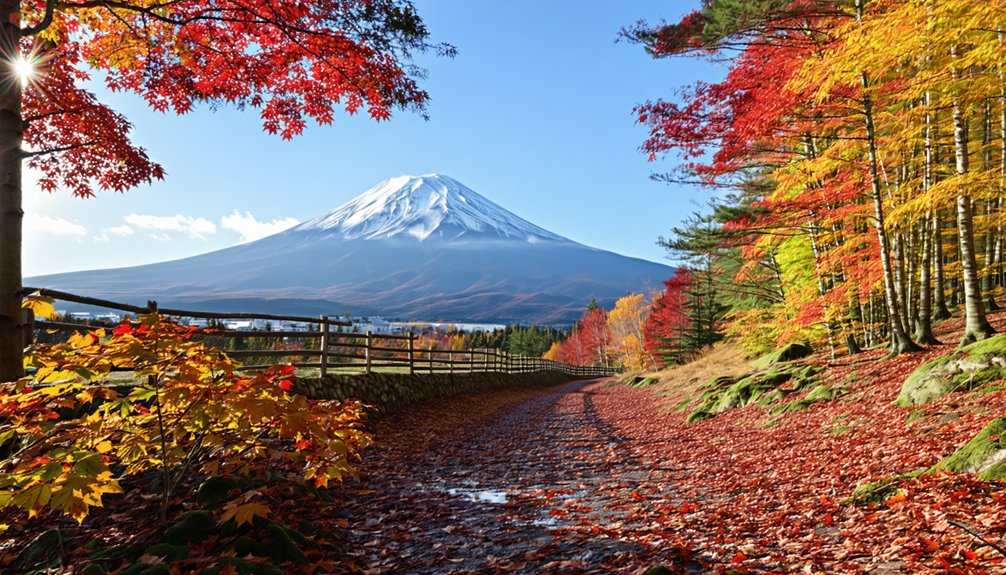
Beyond managing crowds, you’ll need to ponder Japan’s diverse climate zones when timing your visit. From Hokkaido’s subarctic winters to Okinawa’s tropical beaches, each region offers distinct weather patterns that can make or break your travel experience.
- Northern Japan faces brutal winters (-20°C inland) but rewards you with perfect summer hiking conditions and world-class powder snow
- Central regions, including Tokyo and Kyoto, experience all four seasons intensely, with monsoon patterns bringing heavy rains in June-July
- Southern islands enjoy tropical warmth year-round but face seasonal typhoon risks from July through October
The Seto Inland Sea area provides a sweet spot with mild temperatures and less rainfall, making it ideal for year-round exploration. Meanwhile, Kyushu and Shikoku’s subtropical climate delivers hot summers perfect for beach activities, though you’ll want to watch for typhoon forecasts during peak season. The region typically experiences 5-6 typhoons annually between August and October. Understanding these regional variations helps you plan activities that align with your weather preferences.
Cost-Saving Travel Strategies
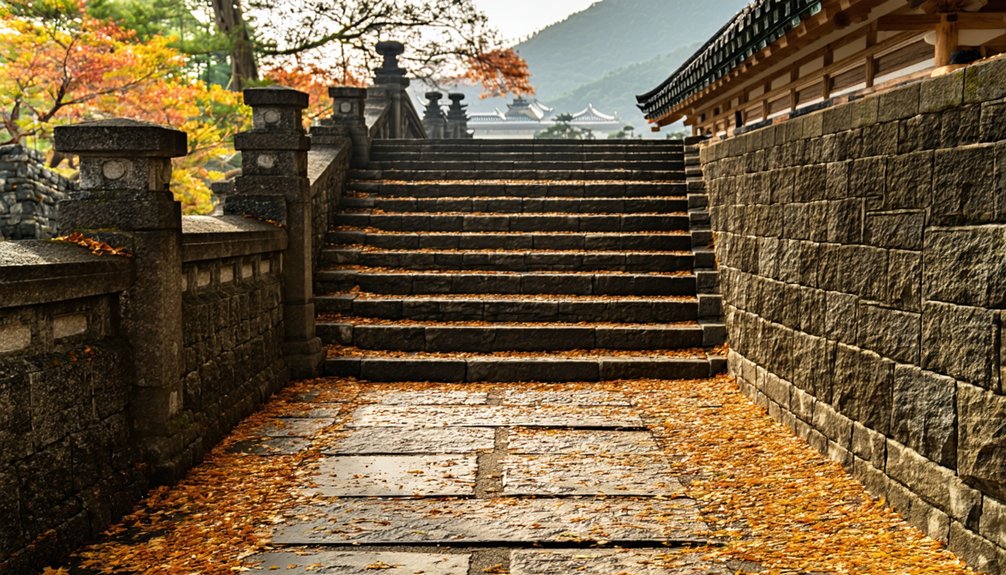
Several proven strategies can dramatically reduce your Japan travel costs without sacrificing the experience. Smart transportation planning starts with evaluating whether a JR Pass suits your itinerary – sometimes regional passes or highway buses offer better value. Consider mixing transport modes and booking budget airlines for longer distances.
Accommodation options range from business hotels to capsule hotels and hostels, with significant savings during off-peak seasons like late autumn and early winter. You’ll find the best rates by avoiding major festivals like Golden Week and Obon. For meals, combine convenience store finds with lunch specials at restaurants. Booking a room without meals at traditional ryokans may seem cost-effective, but check local dining options first.
Take advantage of free cultural sites, including many temples and shrines. Shop at 100-yen stores for souvenirs and utilize tax-free shopping for bigger purchases. Time your visit between November and early March (excluding New Year’s) or during July-August for the most competitive rates on flights and hotels.
